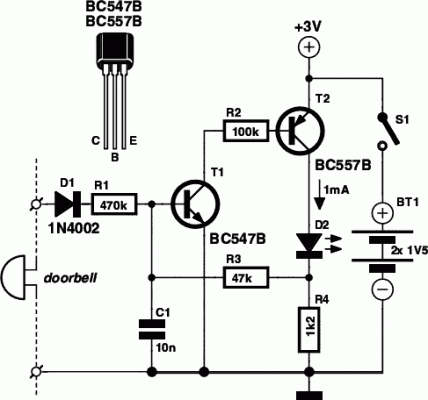Doorbell Memory Circuit Diagram
Description
If you’re expecting an important visitor but you just have to step out for a moment, an electronic doorbell memory can come in handy so you can see whether someone rang while you were out. Of course, you can’t tell whether it was the visitor you were expecting who dropped by then, but a call to the mobile phone of the person concerned can quickly answer that question. A doorbell memory can also save you the trouble of going to the front door (if you live upstairs) when you think you heard the bell but aren’t sure. And if you can’t buy one, then of course you can build one yourself! Read on to find out how.
Circuit diagram:
Circuit description:
It takes only a handful of electronic components to build a handy tale-tale with an LED that indicates whether someone pressed the button of your doorbell. How many times have you thought you heard your doorbell while watching television in the evening? The sound of the well-known ‘ding–dong’ chimes occurs all too often, especially during the many commercials that nowadays remind us at the most inconvenient times that the gripping film we’re watching is only a fantasy.
A glance at the LED of the doorbell memory will tell you whether you have to go to the door or can try to escape the ads by zapping to a different channel. Or if you’re expecting someone but have to make a quick trip to the neighbors to borrow a few beers for the occasion, it can be handy to be able to see whether your visitor already arrived while you were out. If so, you can always call him or her on the mobile to confess that you hadn’t properly prepared for the expected visit.
The circuit is as simple as it is effective. It is connected in parallel with the bell and powered by a 3-V supply formed by two 1.5-V penlight batteries connected in series. The doorbell memory draws so little current that a set of batteries will last several years in normal use. The circuit works as follows. When the supply voltage is switched on with switch S1, capacitor C1 (initially uncharged) prevents transistors T1 and T2 from conducting. LED D2 is off, and the memory is armed.
When the doorbell button is pressed, the memory circuit receives an AC or DC voltage via diode D1, depending on the type of doorbell. It can handle either type. Transistor T1 thus receives a base current, so it starts conducting and drives T2 into conduction. The LED lights up as an indication that the doorbell has rung (i.e. was energized). The combination of transistor T2 and resistor R3 keeps T1 conducting after the bell voltage goes away (when the button is no longer pressed).
The memory remains in this state until switch S1 is opened. This switch thus acts as a reset switch as well as a power switch. The circuit can be assembled compactly on a small piece of perforated prototyping board, so it can be fitted into just about any model of doorbell. The transistors can be replaced by other, equivalent types as long as you use a combination of NPN and PNP types.
circuit from http://www.extremecircuits.net/2010/04/doorbell-memory-circuit-diagram.html
